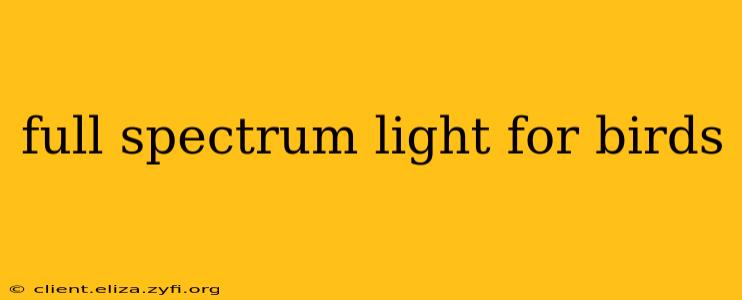Full spectrum lighting is becoming increasingly popular among bird owners, promising a healthier and happier life for their feathered friends. But what exactly is full spectrum light, and does it truly benefit birds? This comprehensive guide will delve into the science behind full spectrum lighting, explore its potential advantages and disadvantages, and answer frequently asked questions.
What is Full Spectrum Lighting?
Full spectrum lighting aims to mimic natural sunlight as closely as possible. Unlike traditional incandescent or fluorescent bulbs that emit a narrow range of wavelengths, full spectrum lights produce a broader spectrum, including ultraviolet (UV) light, which is crucial for many avian species. This broader spectrum more closely resembles the light birds experience in their natural habitats. The specific wavelengths included, and their intensity, vary between bulbs, making careful selection crucial.
Does Full Spectrum Light Benefit Birds?
While the benefits aren't universally proven for all species, many bird owners report positive changes in their pets' behavior and health when switching to full spectrum lighting. These potential benefits include:
- Improved Vitamin D3 Production: UV-B light is essential for birds to synthesize Vitamin D3, crucial for calcium absorption and bone health. Deficiencies can lead to serious health problems.
- Enhanced Breeding and Reproduction: Some studies suggest that full spectrum lighting can positively influence breeding cycles and reproductive success in certain bird species. However, the impact varies significantly depending on the species and other environmental factors.
- Increased Activity and Social Interaction: The more natural light cycle can lead to more natural sleep-wake patterns, resulting in increased activity and more natural social behaviors.
- Brighter and More Vivid Colors: Full spectrum lighting can make a bird's plumage appear more vibrant and colorful, although this is primarily an aesthetic benefit for the owner.
What are the Different Types of Full Spectrum Bulbs?
Several types of bulbs offer full-spectrum capabilities. Understanding the differences is key to choosing the right one for your bird:
- Compact Fluorescent Lamps (CFLs): Relatively inexpensive and energy-efficient, but they may not provide the full spectrum, particularly in the UV-B range, as advertised.
- LED Bulbs: Increasingly popular due to their energy efficiency and long lifespan. High-quality LED bulbs can provide a good full spectrum output. Look for those specifically designed for avian use.
- Specialized Avian Bulbs: Specifically designed for birds, these bulbs usually state their UV-B output clearly, assuring a suitable level for your bird's needs.
How Many Hours of Full Spectrum Light Should My Bird Get?
The ideal amount of light varies drastically depending on the species of bird you own. Some birds require a longer day length during certain times of the year to encourage breeding, while others thrive on a more consistent, shorter day length. Researching the specific needs of your bird species is crucial. A general guideline is to mimic the natural daylight hours in their native habitat as closely as possible. However, always consult an avian veterinarian for tailored advice.
What are the potential drawbacks of using full spectrum light for birds?
While generally safe, using full spectrum lights improperly can have drawbacks. Excessive exposure to UV-B light can damage a bird’s eyes, and incorrect placement of the bulb can lead to overheating or burns. Ensure the bulb is placed appropriately and at a safe distance from the bird's cage and perches.
Can I use full spectrum light for all types of birds?
No. The requirements for full spectrum lighting vary significantly across different bird species. Some species might not benefit from it at all, while others require specific wavelengths and intensities. Consult a veterinarian or avian expert for species-specific guidance.
How do I choose the right full spectrum bulb for my bird?
When selecting a full spectrum bulb, look for ones specifically designed for avian use, clearly indicating the UV-B output. Consider the size of your bird's enclosure and the distance between the bulb and the bird to ensure proper illumination without overheating. Consult your avian veterinarian to ensure your selection is appropriate for your bird’s specific needs.
Where should I place the full spectrum light in my bird's cage?
The placement of the light is crucial. Avoid placing it directly above the bird’s perch, as this can cause overheating. Position the light to provide a balance of illumination and shade. A veterinarian or avian expert can provide detailed advice for your specific situation.
By carefully considering these factors and making an informed decision, you can potentially enhance your bird's health and well-being with full spectrum lighting. Remember always to prioritize the specific needs of your bird's species and consult with a veterinarian for any concerns.
